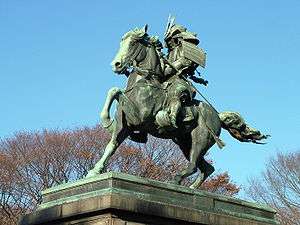Kusunoki Masashige

Kusunoki Masashige (楠木 正成, 1294 – July 4, 1336) was a 14th-century samurai who fought for Emperor Go-Daigo in the Genko War, the attempt to wrest rulership of Japan away from the Kamakura shogunate and is remembered as the ideal of samurai loyalty. His origin has not been validated and it was merely six years between the start of his military campaign in 1331 and his demise in 1336. He received the highest decoration from the Meiji government of Japan in 1880.
"Legend has it that Emperor Go-Daigo had a dream in which he was sheltering under a camphor tree ('Kusunoki'), and that this dream led him to the surname of the warrior who would support him."[1][2]
Kusunoki "was a well-to-do member of the rural gentry" in the Kawachi Province. He claimed descent from Tachibana Moroye, "a great nobleman of the eighth century." Kusunoki was a "scholar and a devout Buddhist."[3]:53
Loyalist
A brilliant tactician and strategist, Kusunoki's cunning defense of two key Loyalist fortresses at Akasaka, the Siege of Akasaka, and Chihaya, the Siege of Chihaya, helped allow Go-Daigo to briefly return to power.[2]:160,164,173,175,180
In 1333, Go-Daigo rewarded Masashige with governorship of Settsu Province and Kawachi Province. Furthermore, he was promoted to Fifth Rank. Later he was appointed to the Records Office and Settlements Board.[4]
However, one of the loyalist generals, Ashikaga Takauji, betrayed Go-Daigo and led an army against Kusunoki and the remaining loyalists.[3] Takauji was able to take Kyoto, but only temporarily before Nitta Yoshisada and Masashige was able to dislodge Takauji, forcing him to flee to the west. By 1336 however, Takauji was a threat to Kyoto again.[4]:130
Kusunoki suggested to the Emperor that they take refuge on sacred Mount Hiei and allow Takauji to take Kyoto, only to swoop down from the mountain, and with the help of the monks of Mount Hiei, trap Takauji in the city and destroy him.[2]:181–182
Go-Daigo was unwilling to leave the capital however, and insisted that Kusunoki meet Takauji's superior forces in the field in a pitched battle. Kusunoki, in what would later be viewed as the ultimate act of samurai loyalty, obediently accepted his Emperor's foolish command and knowingly marched his army into almost certain death.[1]:102-102[3]:126 The battle, which took place at Minatogawa in modern-day Chūō-ku, Kobe, was a tactical disaster. There are two accounts of the proposal made by Kusunoki Masashige to the emperor Go-Daigo, the Taiheiki and the Baisho Ron. One was that they regroup and attack from two sides, the other was that they bring back general Takauji to their side thus balancing the scales. Both arguments were ignored.[2]:181–183[3]:50–52
Kusunoki, his army completely surrounded, was down to only 50 of the original 700 horsemen. According to legend, his brother Masasue's last words were Shichisei Hōkoku! (七生報國; "Would that I had seven lives to give for my emperor!") and Kusunoki Masashige agreed.[2]:185–187[4]:133
Legacy
His son, Kusunoki Masatsura, served the emperor's successor, the 12-year-old Murakami, in a relationship of reciprocal trust and devotion mirroring the figure of his father Kusunoki and keeping the flame of loyalist resistance alive. Masatsura died alongside his brother Masatoki and cousin Wada Takahide in a battle that saw the end of the Kusunoki clan and there followed a less-than-ideal scramble for power and gain among the Courts.[1]:103
Kusunoki "stands in the history of his country as the ideal figure of a warrior, compact of civil and military virtues in a high degree."[3]:53
The parting of Masashige with his son "used to be included in all elementary school readers and was the subject of a patriotic song which was popular in Japanese schools before World War II."[4]:131
Legend
After the full-scale introduction of Neo-Confucianism as a state philosophy by the Tokugawa Shogunate, Kusunoki Masashige, once-called a traitor by the Northern Court, was resurrected with Emperor Go-Daigo as a precursor of Sinocentric absolutists, based upon the Neo-Confucian theories. During the Edo period, scholars and samurai who were influenced by the Neo-Confucian theories created the legend of Kusunoki and enshrined him as a patriotic hero, called Nankō (楠公) or Dai-Nankō (大楠公), who epitomized loyalty, courage, and devotion to the Emperor. Kusunoki later became a patron saint of sorts to World War II kamikaze, who saw themselves as his spiritual heirs in sacrificing their lives for the Emperor.
Honours
- Senior First Rank (July 20, 1880; posthumous)
References
- 1 2 3 Turnbull, Stephen (1977). The Samurai, A Military History. MacMillan Publishing Co., Inc. p. 95. ISBN 0026205408.
- 1 2 3 4 5 Sato, Hiroaki (1995). Legends of the Samurai. Overlook Duckworth. pp. 158–159. ISBN 9781590207307.
- 1 2 3 4 5 Sansom, George (1961). A History of Japan, 1334-1615. Stanford University Press. pp. 43–44. ISBN 0804705259.
- 1 2 3 4 Morris, Ivan (1975). The Nobility of Failure. Holt, Rinehart and Winston. p. 127. ISBN 9780030108112.
External links
| Wikimedia Commons has media related to Kusunoki Masashige. |